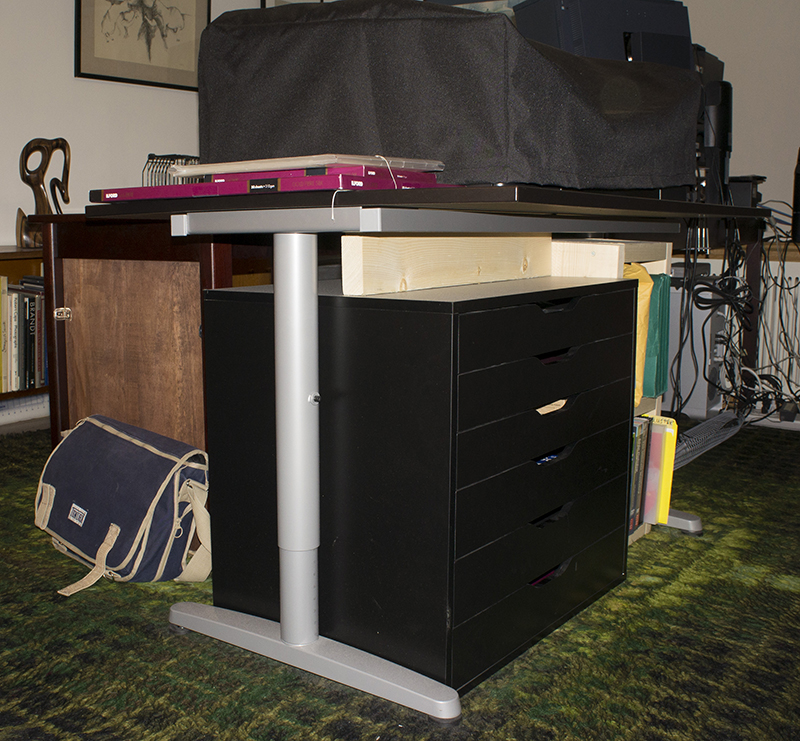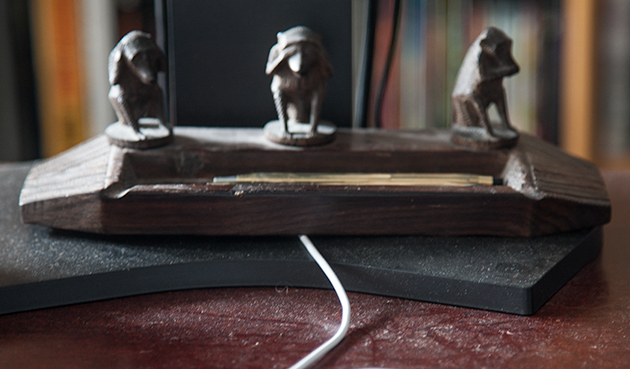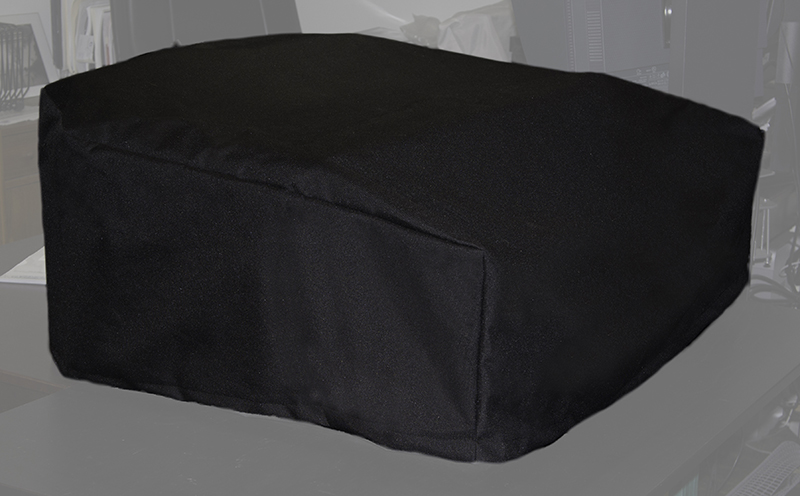Printer manufacturers make great printers; but they often don’t offer some really useful accessories. The two I have in mind are a printer stand and a dust cover.
Printer stands are not an issue for the behemoth models that come with bespoke stands, but for the larger desktops, for example theEpson 4900, I’ve received inquiries about what I put it on. As well, there’s been a fair bit of discussion about whether dust can clog the nozzles.
Let’s start with the furniture. I had quite an issue with this, and as I mentioned, I’m not alone. The 4900 is a hefty piece of machinery and its head movement also has heft; so when it moves back and forth on its rails making a print, if the furniture the printer sits on isn’t inert, some of this carriage movement causes the underlying support to shake gently with the carriage; I’m not convinced this is a great idea.
When I bought the printer I shopped around for a solution available here in Toronto, and discovered to my dismay that the ideal approach – a solid wood or steel cabinet with a very rigid frame, closed on the four sides (one side having drawers or doors) would have cost me a minimum of $600 (and some were well over $1000). Instead I went to IKEA and searched the most stable option available there, the table you see in the photo below.

Support Structure for Epson 4900
In the shop, it seemed very steady, and it wasn’t all that expensive. I also bought a complementary set of drawers (the black cabinet) to put underneath it, and for both together I spent considerably less than the “ideal solution” would have cost. But when I assembled it all very firmly and ran the printer, there was mild shake. Ugh. Lesson learned: tables with leg assemblies aren’t assuredly stable enough.
So I bought some thick lumber and built a cube-shelf that tightly squeezed-out all the remaining space under the table, rigidified the whole structure and gave me some additional storage space. The wood span you see across the black IKEA cabinet, jammed into the table assembly on the one side and the cube-shelf on the other, is the “finishing touch”. OK it works – well, but how to avoid all this trouble: buy the right thing for the job to begin with. Or better still Epson: remember the bespoke cabinet for the 4800? Yes, it was a darn heavy monster, but that’s what’s needed “in spades” for the 4900!
Now, you’ll see in the image above that my 4900 is COVERED. How many of you own one of those? Even in supposedly clean houses in supposedly clean neighbourhoods, dust accumulates more than we’d like to believe. What you see below is the result of not dusting my desk after about a week of absence. (Yuch, and why the “three evils” are there – and no, I don’t usually live with this kind of dust, believe me). The printer sits beside the desk.

Dust is the 4th Evil
There’s been a lot discussion on this website’s Forum about clogs in certain models of Epson printers. There’s been much speculation about how and why it happens. The fact is, few of us can know for sure; however at least one proposition seems reasonably sensible: if particulates can mix with ink on the print head, perhaps the ink won’t flow properly. These nozzles are awfully small – particularly in a 4900, which packs twice as many per square inch as its 4800 and 3800 predecessors. With ink being expelled through very tiny holes, it’s reasonable to surmise that a collection of very tiny particulates mixed with ink and congeled could jeopardize the process.
As well the 4900 has a roll holder. Despite the plastic cover protecting the top half of the roll, the lower half is exposed, such that some of the paper’s printable surface is exposed to the elements in your workspace, unless removed and packed away till needed, or more conveniently – covered. The top paper feed also has a plastic cover, but you can easily slide paper through its sides and back – hence it would seem dust could enter there too.
Then there is the top of the front tray that receives the back of prints coming through the printer. If that were dusty, dust could transfer to the back of the print, and if you stacked the prints, it could be attracted onto the surface of the print below.
I haven’t found any scientific data that supports this proposition, but keeping these machines well protected from dust just seems like “a good thing to do”. Hence I’ve often wondered why the printer manufacturers don’t provide dust covers for the desktop printers as an optional accessory, but they don’t. I remember back in the 1950s and 1960s no one bought a camera without the case – those brown leather carry cases were “de rigueur” back then, but those went by the wayside as the years rolled on, and third-party vendors now sell all manner of coverings to protect our gear.
So I’ve been on the look-out for a decent way to cover my Epson 4900 – something a bit more elegant and protective than throwing a large piece of cloth over it – which can also shed fuzz. Finally, a friend alerted me that one such solution does indeed exist. Kathie Weston, member of the Weston photographic family in Carmel Valley, California, designed and hand-makes a custom cover for the Epson 4900. This has to be good news for the many Epson 4900 owners out there who, perhaps like me, think it would be good to protect their printers from dust.
So I ordered one of Kathie’s covers and tried it on for size. Here’s what the cover looks like on the printer.

Kath Weston’s Printer Cover for the Epson 4900
It protects the printer and fits well. It covers the whole printer comfortably enough to slip it on and off with ease. The quality is very good. It’s made from durable, medium-weight nylon, and the seams are securely sewn. You can obtain these covers by visiting Kathie athttp://www.westonsdustcovers.com/.
There’s at least one competing product also available, for example, http://www.amazon.com/Epson-Stylus-Printer-Cover-Protector/dp/B00691MJ3U/ref=sr_1_1?ie=UTF8&qid=1345830067&sr=8-1&keywords=Epson+4900+printer+cover; however, I really liked the look and style of Kathie’s cover, so that’s the one I got. When it came and I “tried it on for size” I was very pleased.
Summing-up, two useful ideas for maintaining your 4900, or other printer of similar ilk: support it well and keep it covered when not in use.
September, 2012
Mark D Segalis a regular contributor to the Luminous-Landscape website and has been printing with Epson professional printers since the Epson 2000P model was introduced over a decade ago. Mark is also the author of “Scanning Workflows with SilverFast 8, SilverFast HDR, Adobe Photoshop Lightroom and Adobe Photoshop“, published May 2012 by LaserSoft Imaging A.G.
